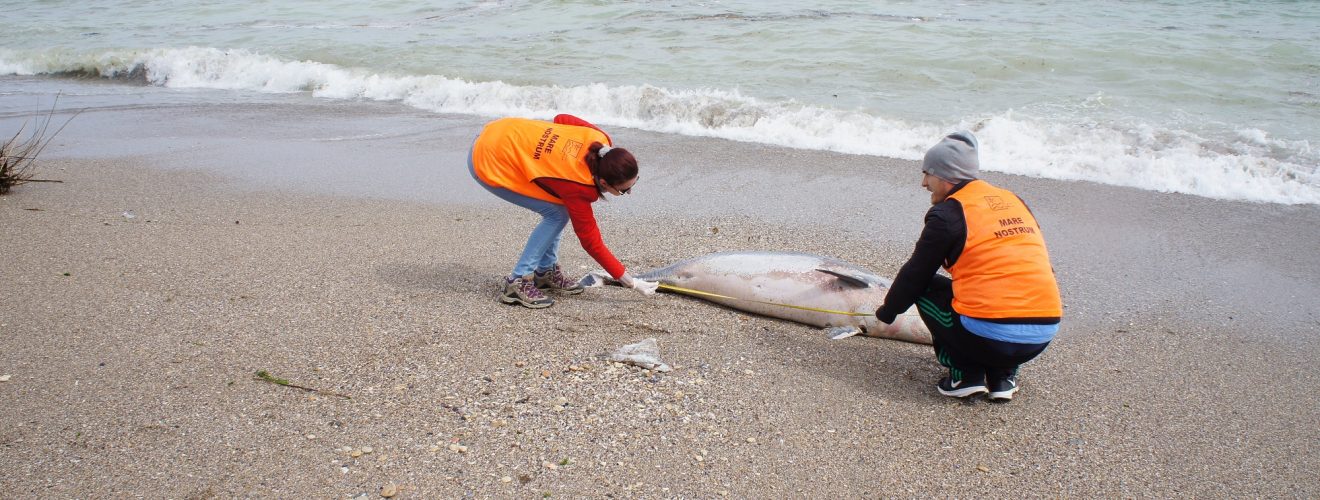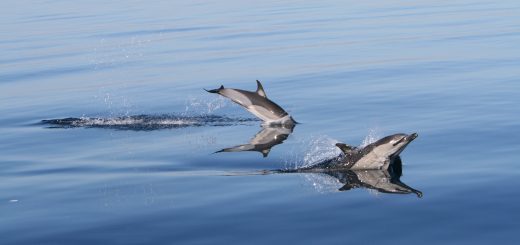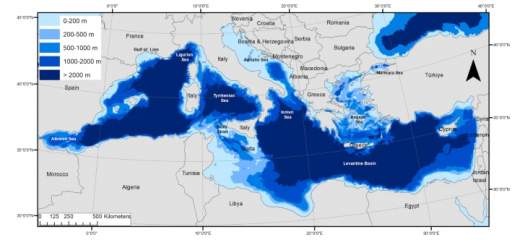
According to the recommendations listed on Annex VII of the 11th Ordinary Meeting of the Contracting Parties of the Barcelona Convention and its Protocols of the Mediterranean Action Plan, UNEP (Malta, 27-30 October 1999), relating to the ulterior implementation of the Action Plan for Cetacean Conservation in the Mediterranean Sea and other initiatives, the co-ordination of the information of stranded cetaceans on the coast of the Mediterranean countries is required for a better knowledge of cetaceans and their eventual protection and conservation.
Cetacean strandings, in addition to raising social awareness for these animals and for marine biodiversity, represent an important tool for the development of scientific programmes on cetacean conservation. The occurrence of stranded dolphins and whales provides an invaluable opportunity to investigate mortality causes and the impact of human interactions, to assess the importance of potential threats (by analysis of accumulated pollutants and toxins), and to gain insights on aspects of their population biology: reproduction, development, feeding habits, etc. In the last years, thanks to the development of molecular techniques, cetacean strandings represent also a chance for collecting small tissue samples for population genetic studies. These data altogether can be used to determine the health status and to identify conservation problems of cetacean populations and reveal unusual mass mortality episodes (Geraci and Lounsbury, 1993).
In countries where the concern for the protection of cetaceans is higher, stranding networks have been developed over the last decades. The establishment of stranding networks and the submission of data to a centralised database facilitates the collection and dissemination of information. Besides, it affords to monitor health trends in marine mammal populations by relating health data with available information on physical, chemical, environmental, and biological parameters, and co-ordinate effective responses to unusual mortality events (Becker et al. 1994).
Also working groups dealing with marine mammal unusual mortality events have been established, in some countries, to delineate criteria for determining when such an event is underway and to provide guidance to respond to them (Wilkinson 1996). In addition, national marine mammals tissue banks have been created in connection with national stranding networks. Such banks have the purpose of providing samples for future retrospective analyses, for new analyses of interest and for future analyses using improved analytical techniques. Marine Mammal Tissue Banks constitute a resource of samples that have been collected and stored in a systematic and well-documented manner to compare results over time and to identify whether environmental trends exist (Becker et al. 1999)
Thus, the establishment of standards to keep the information and samples from cetacean strandings in the Mediterranean waters becomes relevant. In this context, it is necessary to compile all details of cetacean strandings, including an inventory of the samples taken, in a single database maintained by a Mediterranean Database of Cetacean Strandings (MEDACES).
In November 2001, the 12th Ordinary Meeting of the Contracting Parties to the Convention for the Protection of the Mediterranean Sea against Pollution and its Protocols, within the “Biological Diversity and Specially Protected Areas” section, recommended for implementing the Action Plan for the Conservation of Cetaceans in the Mediterranean Sea, to approve the offer by Spain with regard to the establishment in Valencia of a Mediterranean database on cetacean strandings (MEDACES). The Regional Activity Centre for Specially Protected Areas (RAC/SPA) is the depositary for the database, whose management is entrusted to the University of Valencia’s Cavanilles Biodiversity Institute (ICBIBE), with the financial support of the Spanish Ministry of the Environment, and Rural and Marine Affairs (MMA) and ACCOBAMS. The ICBIBE provides the human and material resources necessary to implement MEDACES. This database strictly adheres to a deontological code (see About MEDACES/Deontological code).
The Mediterranean Database of Cetacean Strandings has been expanded to cover regions adjacent to the Mediterranean, as the Black Sea and the contiguous Atlantic waters as defined in the Agreement on the Conservation of Cetaceans of the Black Sea, Mediterranean Sea and contiguous Atlantic area.
References
Strandings of cetaceans and sea turtles in the Alboran Sea and Strait of Gibraltar: a long–time glimpse of the north coast (Spain) and the south coast (Morocco). Rojo–Nieto, E., Álvarez–Díaz, P. D., Morote, E., Burgos–Martín, M., Montoto–Martínez, T., Sáez–Jiménez, J. & Toledano, F., 2011. Animal Biodiversity and Conservation, 34.1: 151–163
Beaked Whale Strandings and Naval Exercises D’Amico, A., Gisiner RC., Ketten,D., Hammock J.A., Johnson,CL., Tyack, and Mead,J. Aquatic Mammals 2009, 35(4), 452-472, DOI 10.1578/AM.35.4.2009.452
BEST PRACTICE IN RESCUE. PROCEEDINGS OF THE ECS WORKSHOP European Cetacean Society’s 27th Annual Conference. Portugal. Barnett, J., Dolman, S D., J., Simmonds M P. and Wright A J. SPECIAL PUBLICATION SERIES NO. 57. January 2014
Life-history tables of the Mediterranean fin whale from stranding data. Arrigoni, M., Manfredi, P., Panigada, S. Bramanti, L & Santangelo, G. Marine Ecology 32 (Suppl. 1) (2011) 1–9
Resurgence of Morbillivirus infection in Mediterranean dolphins off the French coast Keck, N., Kwiatek O., Dhermain, F., Dupraz, F., Boulet, H., Danes, C., Laprie, C., Perrin, A., Godenir J., Micout, L. Libeau, G. Veterinary Record (2010) 166, 654-655
Angliss, R.P. and D.P. DeMaster. 1998. Differentiating serious and non-serious injury of marine mammals taken incidental to commercial fishing operations: report of the serious injury workshop, 1-2 April 1997, Silver Spring, Maryland. U.S. Department of Commererce, NOAA Technical Memorandum NMFS-OPR-13. 48 p.
Bannister, J.L., C.M. Kemper and R. Warneke. 1996. The Action plan for Australian cetaceans. Australian Conservation Agency, Canberra. 242 p.
Becker, P., D. Wilkinson and T. Lillestolen. 1994. Marine Mammal Health and Stranding Response Program: program development plan. U.S. Department of Commererce, NOAA Technical Memorandum NMFS-OPR-94-2. 35 p.
Becker, P., Porter, B.J., Mackey, E.A., Schantz, M.M., Demiralp, R. and Wise, S.A. (1999). National Marine Mammals Tissue Bank and Quality Assurance Program: Protocols, Inventory, and Analytical Results. U.S. Department of Commerce, NISTJR Technical Memorandum, NISTIR – 6279, 183 pp.
Blaylock, R.A., B.G. Mase and C.P. Driscoll [eds.]. 1995. Final report on the workshop to coordinate large whale stranding response in the southeast U.S. U.S. Dept. Commerce, NOAA, National Marine Fisheries Service, Southeast Fisheries Science Center, Charleston Laboratory, Charleston, South Carolina. SEFSC Contributions MIA-96/97-43. 38p.
Dierauf, L.A. 1994. Pinniped forensic, necropsy and tissue collection guide. U.S. Department of Commererce, NOAA Technical Memorandum NMFS-OPR-94-3. 80 p.
Geraci, J.R. and Lounsbury, V.J. (1993) Marine Mammals Ashore: a field guide for strandings. Texas A&M Sea Grant Publication, 305 pp. (electronic version in CD Rom, NOAA and National Aquarium in Baltimore).
Kuiken, T. [ed.]. 1996. Diagnosis of by-catch in cetaceans. Proceedings of the second European Cetacean Society workshop on cetacean pathology, de Montpellier, France, 2 March 1994. European Cetacean Society Newsletter No. 26 – Special Issue. 43 p.
Kuiken, T. and M.G. Hartmann [eds.]. 1991. Dissection techniques and tissue sampling. Proceedings of the first European Cetacean Society workshop on cetacean pathology, Leiden, The Netherlands, 13-14 September 1991. European Cetacean Society Newsletter No. 17 – Special issue. 39 p.
Loughlin, T. R. [ed.]. 1994. Marine mammals and the Exxon Valdez. Academic Press, Inc., San Diego and London.
RAC/SPA (1998). Cetacean stranding studies in the Mediterranean. Meeting of experts on the implementation of the Action Plans for marine mammals (monk seal and cetaceans) adopted within Mediterranean Action Plan, IJNEP (QCA)/MED WG. 146/mf. 5, 44 pp.
St. Aubin, D.J., J.R. Geraci and V.J. Lounsbury [eds.]. 1996. Rescue, rehabilitation, and release of marine mammals: an analysis of current views and practices. Proceedings of a workshop held in Des Plaines, Illinois, 3-5 December 1991. U.S. Department of Commererce, NOAA Technical Memorandum NMFS-OPR-8, 65 p.
Trillmich, F. and K.A. Ono [eds.]. 1991. Pinnipeds and El Ni.o: responses to environmental stress. Springer-Verlag, Berlin.
Wilkinson, D.M. 1996. National contingency plan for response to unusual marine mammal mortality events. U.S. Department of Commererce, NOAA Technical Memorandum NMFS-OPR-9. 118 p.





